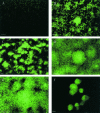Biofilm development and cell death in the marine bacterium Pseudoalteromonas tunicata
- PMID: 15184116
- PMCID: PMC427794
- DOI: 10.1128/AEM.70.6.3232-3238.2004
Biofilm development and cell death in the marine bacterium Pseudoalteromonas tunicata
Abstract
The newly described green-pigmented bacterium Pseudoalteromonas tunicata (D2) produces target-specific inhibitory compounds against bacteria, algae, fungi, and invertebrate larvae and is frequently found in association with living surfaces in the marine environment. As part of our studies on the ecology of P. tunicata and its interaction with marine surfaces, we examined the ability of P. tunicata to form biofilms under continuous culture conditions within the laboratory. P. tunicata biofilms exhibited a characteristic architecture consisting of differentiated microcolonies surrounded by water channels. Remarkably, we observed a repeatable pattern of cell death during biofilm development of P. tunicata, similar to that recently reported for biofilms of Pseudomonas aeruginosa (J. S. Webb et al., J. Bacteriol. 185:4585-4595, 2003). Killing and lysis occurred inside microcolonies, apparently resulting in the formation of voids within these structures. A subpopulation of viable cells was always observed within the regions of killing in the biofilm. Moreover, extensive killing in mature biofilms appeared to result in detachment of the biofilm from the substratum. A novel 190-kDa autotoxic protein produced by P. tunicata, designated AlpP, was found to be involved in this biofilm killing and detachment. A Delta alpP mutant derivative of P. tunicata was generated, and this mutant did not show cell death during biofilm development. We propose that AlpP-mediated cell death plays an important role in the multicellular biofilm development of P. tunicata and subsequent dispersal of surviving cells within the marine environment.
Figures



References
-
- Anderson, G. G., J. J. Palermo, J. D. Schilling, R. Roth, J. Heuser, and S. J. Hultgren. 2003. Intracellular bacterial biofilm-like pods in urinary tract infections. Science 301:105-107. - PubMed
-
- Auschill, T. M., N. B. Arweiler, L. Netuschil, M. Brecx, E. Reich, A. Sculean, and N. B. Artweiler. 2001. Spatial distribution of vital and dead microorganisms in dental biofilms. Arch. Oral Biol. 46:471-476. - PubMed
-
- Costerton, J. W., P. S. Stewart, and E. P. Greenberg. 1999. Bacterial biofilms: a common cause of persistent infections. Science 284:1318-1322. - PubMed
Publication types
MeSH terms
Substances
Associated data
- Actions
LinkOut - more resources
Full Text Sources
Other Literature Sources
Molecular Biology Databases
Research Materials

